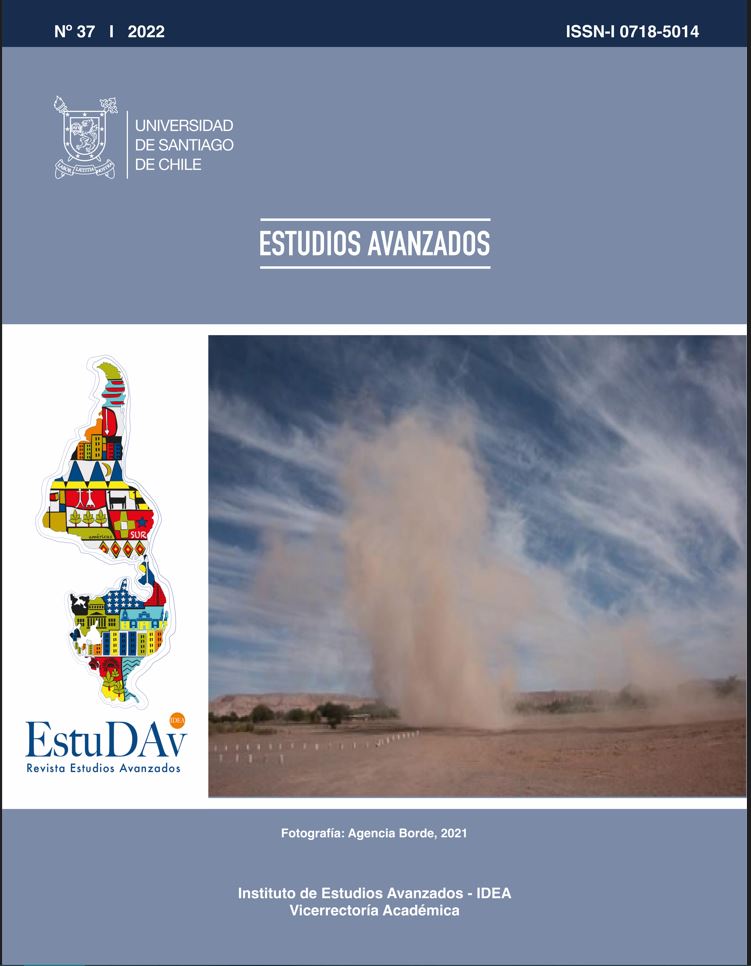Landscape, Body and Time: The presence and the Disembodied Gaze in the Work of Agencia de Borde
DOI:
https://doi.org/10.35588/estudav.v0i37.5904Keywords:
landscape, body, time, presence, dronesAbstract
This article proposes the analysis of the strategies with which the Chilean collective Agencia de Borde (AB) developed Una explosión sorda y grave, no muy lejos (2017)—installation belonging to the project Campos Minados—to problematize the landscape-technique-representation relationship. The work is based on the exploration of the minefields sown between the years 1973 and 1983 in the Atacama Desert. An untouchable territory, out of circulation, that in the face of its explosive evolution becomes ephemeral and imagined, in which a drone and its digital eye appear as the only possibility to visually access inadmissible places. Under these conditions, the annulment of the territory and its impossibility of inhabiting it, the text focuses on two aspects: on the one hand, on the problematization of the concepts of landscape, presence and listening. And on the other, to think about the disappearance of the body in the face of the measured experience of the registration of the machinic eye and digital drone. In this way, in the face of the savage effect that military ambitions have exerted on places, the analysis proposes to think about the tension present in the representation of territories through contemporary creative practices.
Downloads
References
Agencia de Borde (2021). Border Agendy Art Collective. En https://borderagency.net/ (consultado 28/12/2022).
____. (2020). ¿Y si no se puede confiar en el suelo bajo tus pies? Santiago, Santiago, Ministerio de las Culturas, las Artes y el Patrimonio, Gobierno de Chile.
____. (2019). The Landmine Project. Santiago, Ministerio de las Culturas, las Artes y el Patrimonio, Gobierno de Chile. En https://www.thelandmineproject.com/ (consultado 28/12/2022).
Allen, J. (2010). “That Eye, The Sky”. En Frieze, 01 de junio de 2010. En from https://www.frieze.com/article/eye-sky (consultado 28/12/2022).
Andermann, J. (2018). Tierras en trance: arte y naturaleza despueÌs del paisaje. Santiago, Metales Pesados.
Bourriaud, N. y Mattoni, S. (2014). PostproduccioÌn: la cultura como escenario, modos en que el arte reprograma el mundo contemporaÌneo. Buenos Aires, Adriana Hidalgo.
Chamayou, G. (2016). TeoriÌa del dron. Barcelona, Ned.
Crary, J. (2008). Las técnicas del observador: Visión y Modernidad en el siglo XIX. Murcia, Cendeac.
De Certeau, M.D.; Giard, L. y Mayol, P. (2010). La invención de lo cotidiano. Ciudad de México, Universidad Iberoamericana.
Emmelhainz, I. (2015). “Conditions of Visuality Under the Anthropocene and Images of the Anthropocene to Come”. E-flux Journal 26. En https://www.e-flux.com/journal/63/60882/conditions-of-visuality-under-the-anthropocene-and-images-of-the-anthropocene-to-come/
Fischer-Lichte, E. (2017). “Sobre la producción performativa de la materialidad”. En Fischer-Lichte, E. EsteÌtica de lo performativo. Madrid, Abada.
Goffard, N. (2019). Intramuros palimpsestos sobre arte y paisaje. Santiago, Metales Pesados.
Groys, B. y Rocca, C.P. (2018). Volverse puÌblico: las transformaciones del arte en el ágora contemporaÌnea. Buenos Aires, Caja Negra.
Hensley, N. (2016). “Drone Form: Word and Image at the End of Empire”. E-flux Journal 72. En https://www.e-flux.com/journal/72/60482/drone-form-word-and-image-at-the-end-of-empire/ (consultado 28/12/2022).
Hernández, M. (2020). “Contratiempos del Arte Contemporáneo”. En Hernández, M. El arte a contratiempo. Madrid, Akal: 16-28.
Hui, Y. (2017). “¿Qué es un objeto digital?”. Virtualis 7(15): 81-96.
Jamenson, F. (2003). “The End of Temporality”. Critical Inquiry 19: 695-718.
____. (2011). El posmodernismo o la loÌgica cultural del Capitalismo Avanzado. Barcelona, PaidoÌs.
Lyotard, J. (1998). “El tiempo, hoy”. En Lyotard, J. Lo inhumano. Charlas sobre el tiempo. Buenos Aires, Manantial: 65-83.
Maderuelo, J. (2005). El paisaje: geÌnesis de un concepto. Madrid, Abada.
Mbembe, A. y Beneduce, R. (2016). Necropolítica. Verona, Ombre Corte.
Mitchell, T.W. (2009). Landscape and Power. Chicago, University of Chicago Press.
Montero, M.; Salas, P. y Melo, S. (2018). “The Landmine Project: How to Cross a Fractured Territory”. International Journal of Culture and History 4(4): 84-87. DOI https://doi.org/10.18178/ijch.2018.4.4.127
Nancy, J.L. (2013). “Cuerpo-Teatro. El cuerpo como escena”. En Nancy, J.L. La particioÌn de las artes. Valencia, Universidad PoliteÌcnica de Valencia.
____. (2005). “Uncanny Landscape”. En Nancy, J.L. The Ground of the Image. Nueva York, Fordham University Press: 51-62.
____. (2008). Las musas. Buenos Aires, Amorrortu.
Parks, L. (2007). “Orbital Performers and Satellite Translators: Media Art in the Age of Ionospheric Exchange”. Quarterly Review of Film and Video 24: 207-216. DOI https://doi.org/10.1080/10509200500486288
Ramos Torres, R. (2014). “AtemporalizacioÌn y presentificacioÌn del mundo social en la sociologiÌa contemporaÌnea”. PoliÌtica y Sociedad 51(1): 147-176.
Roger, A.; Maderuelo, J. y Veuthey, M. (2013). Breve tratado del paisaje. Madrid, Biblioteca Nueva.
Rojas, S. (2021). “El arte en la frontera del Posthumanismo”. Revista [cuatrotreintaitrés] 04: 3-7.
____. (2018). Campos minados: paisajes de un planeta deshabitado. En https://sergiorojas.cl/wp-content/uploads/2020/05/Campos-Minados-1.pdf (consultado 28/12/2022).
____. (2012). El arte agotado. Santiago, SangriÌa.
Seel, M. y Restrepo, P.S. (2010). EsteÌtica del aparecer. Buenos Aires y Madrid, Katz.
Stahl, R. (2013). “What the Drone Saw: The Cultural Optics of the Unmanned War”. Australian Journal of International Affairs 67: 659-674. DOI https://doi.org/10.1080/10357718.2013.817526
Steyerl, H. (2011). “In Free Fall: A Thought Experiment on Vertical Perspective”. E-flux 24. En https://www.e-flux.com/journal/24/67860/in-free-fall-a-thought-experiment-on-vertical-perspective/ (consultado 28/12/2022).
Steyerl, H.; Berardi, F. y ExpoÌsito, M. (2014). Los condenados de la pantalla. Buenos Aires, Caja Negra.
Vara Sánchez, C. (2015). “De la presencia como lo irreductible en la experiencia estética”. TALES. Revista de Filosofía 5: 340-352.
Vaskes Santches, I. (2011). “Posmodernidad estética de Frederick Jameson: pastiche y esquizofrenia”. Praxis Filosófica 33: 53-74. DOI https://doi.org/10.25100/pfilosofica.v0i33.3404
Weizman, E. (2002). “1. Introduction to The Politics of Verticality”. Open Democracy, 23 de abril 2022. En https://www.opendemocracy.net/en/article_801jsp/ (consultado 28/12/2022).



